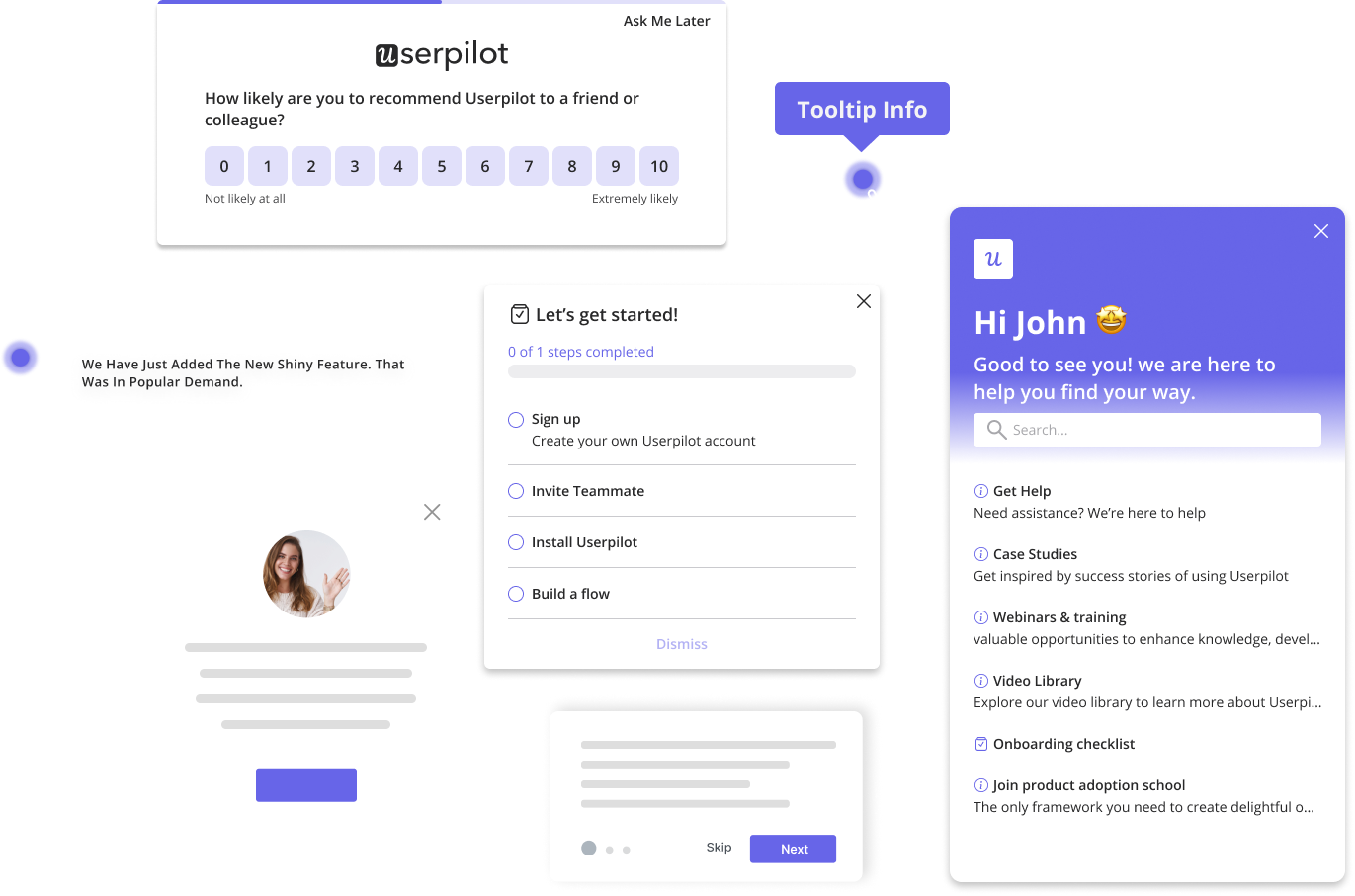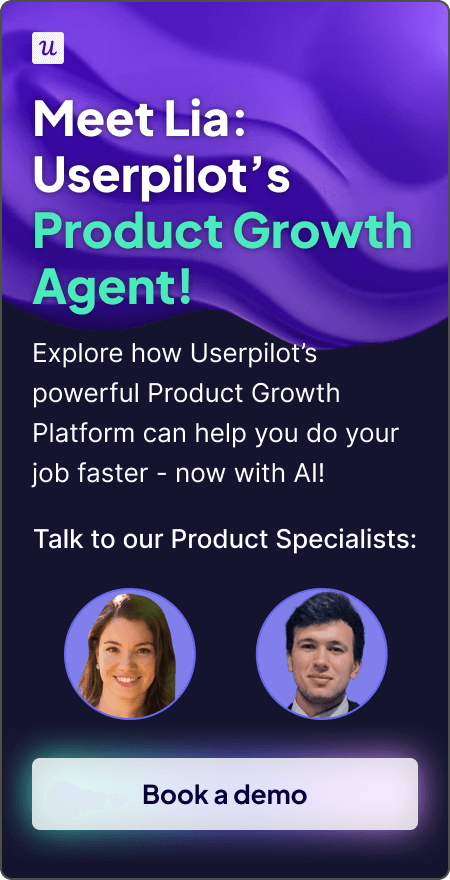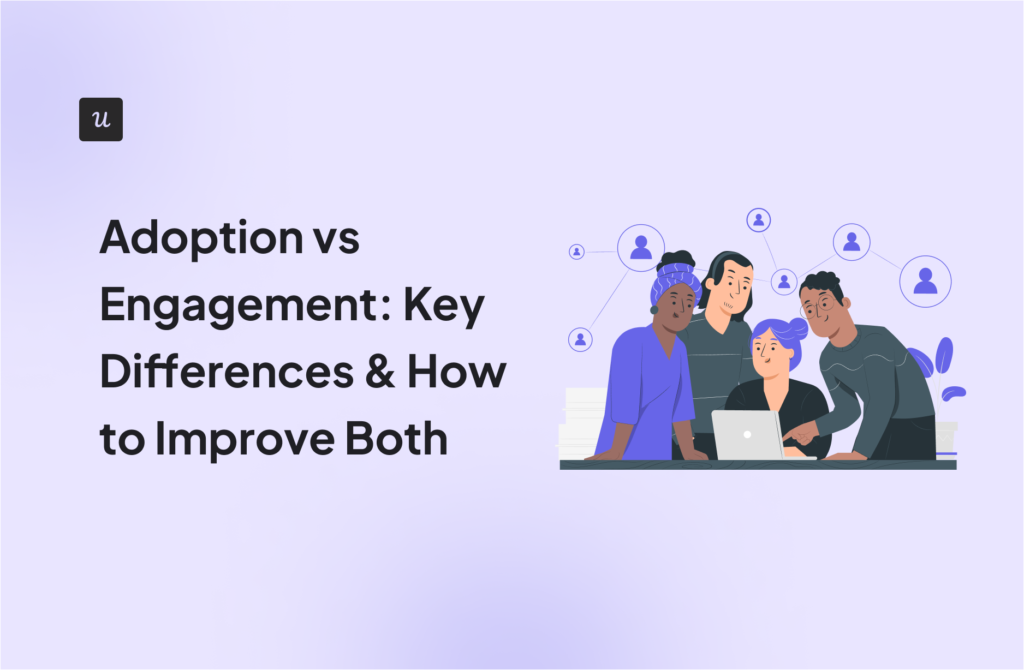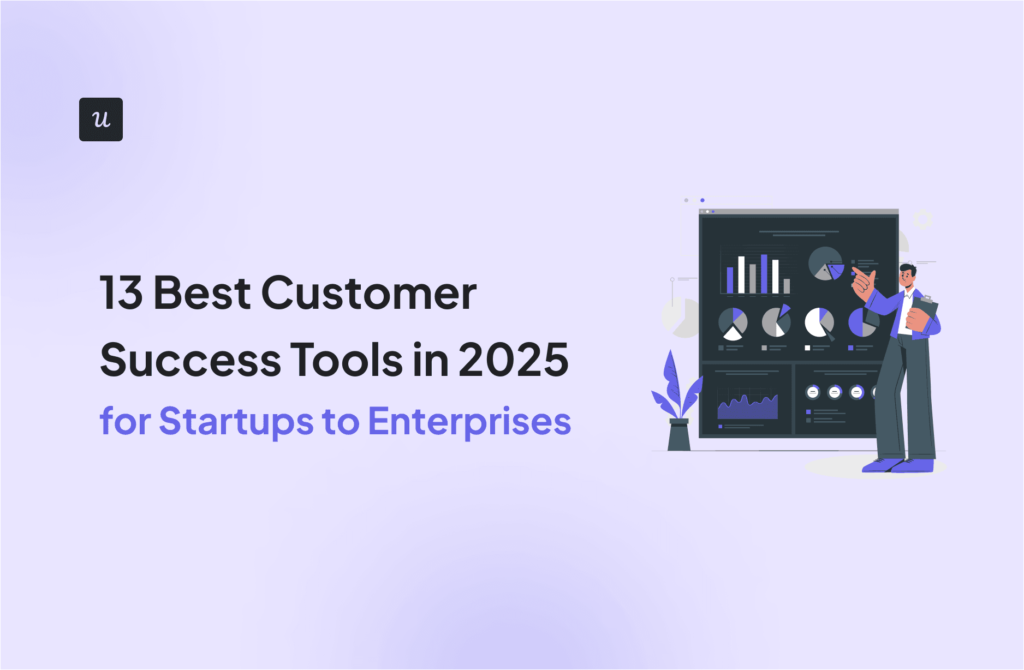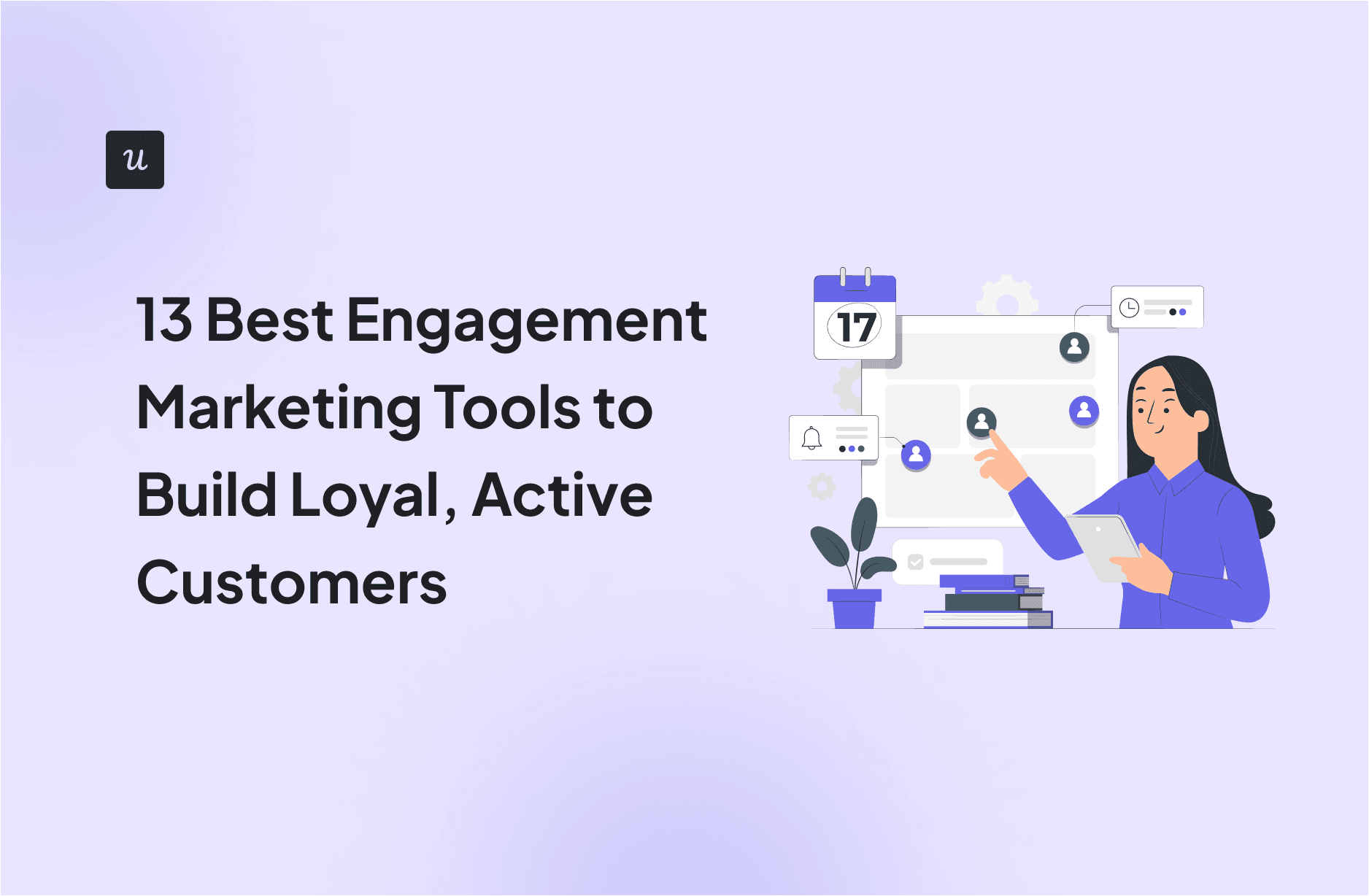
13 Best Engagement Marketing Tools to Build Loyal, Active Customers
Engagement marketing tools equip you to create interactive, personalized experiences that meet customer needs and help them achieve their goals faster. This contrasts with traditional push marketing, which focuses only on driving transactions.
As a product manager who has tried both, I know engagement marketing is far better at reducing churn, driving conversion, and boosting long-term loyalty. Research confirms the same trend: Attentive’s 2025 report shows 81% of consumers ignore irrelevant messages, and 96% say they become more willing to commit to a brand after at least one personalized experience.
This article will provide a deep dive into some of the top customer engagement tools in the market right now.
For each tool, I’ll cover:
- Overall G2 rating to give you a feel of customer sentiment.
- Key features.
- Pros and cons.
- Pricing details.
Find the Right Engagement Marketing Tools for Your Business
Answer a few quick questions to see what you should prioritize.
What is your #1 goal right now?
How are you currently guiding users in-app?
How personalized is your user onboarding?
You’re ready to accelerate your growth.
Based on your answers, an engagement marketing platform can help you build the personalized, data-driven experiences you need to hit your goals. See how Userpilot’s powerful, code-free engagement marketing tools can help.
Try Userpilot Now
See Why 1,000+ Teams Choose Userpilot
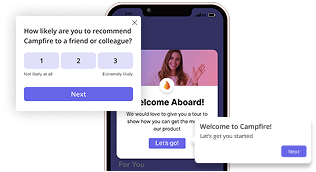
Why invest in a customer engagement platform?
From my experience and from what I’ve seen with our customers, the right customer engagement platforms consistently deliver four big benefits:
- Improve customer retention: Over 50% of customers churn quietly without ever sharing their reasons for leaving. By the time you send an exit survey, most won’t respond, and the few who do are usually already lost. A customer engagement platform helps you get ahead of this by spotting early churn signals. With tools like behavior tracking, contextual surveys, and timely nudges, you can uncover frustrations early, improve customer engagement, and address issues before they push customers away.
- Personalize customer journeys: According to Medallia’s 2024 personalization report, 82% of customers say personalization directly influences their brand choice. Even more telling, customers who feel their experiences are “very personalized” rate their satisfaction at 9.4 out of 10, while those without personalization give only a 6.5.
That’s a massive gap, but you can stay on the winning side by using customer engagement software to design dynamic customer journeys that adapt to each user’s behavior and needs. - Align sales, marketing, and customer success: 68% of organizations in Dataversity’s trends report cited data silos as their biggest data management challenge. This often leads to slower productivity, duplicated efforts, and inconsistent messaging across touchpoints. A unified customer engagement platform solves this problem by giving your customer-facing teams a single source of truth. With shared visibility into customer interactions, every team can work in sync and deliver consistent, personalized experiences that build trust and move customers forward in their journey.
- Data-driven insights: Customer engagement tools allow you to track behaviors, observe patterns, and understand where users succeed or struggle. These valuable customer insights will help you double down on what works and continuously refine your engagement strategy.
13 Best engagement marketing tools for SaaS teams
Whenever I’m evaluating a customer engagement platform, I usually ask myself a few simple but telling questions:
- Does it make it easier to understand user behavior?
- Can it personalize experiences at scale without a ton of manual work?
- Will it keep sales, marketing, and success teams aligned around a single source of truth?
- Does it provide the kind of insights I need to continuously refine our strategy?
- Is the pricing fair and scalable as our needs grow?
For me, the best platform is the one that answers yes to all or most of these questions. With that in mind, here are 13 customer engagement tools that stand out for SaaS teams:
1. Userpilot
Userpilot is an all-in-one engagement platform for web and mobile apps. It combines product analytics, session replay, in-app guidance, and in-app surveys so you can understand behavior and personalize experiences without a heavy engineering lift.
Overall G2 rating: 4.6/5 ⭐️
Key features:
- Automatic event tracking: Once installed, Userpilot automatically captures all user clicks, text inputs, and form submissions so you can understand the impact of your in-app flows without writing any code. You can also label these raw events to make them reusable across funnels, reports, and in-app experiences.
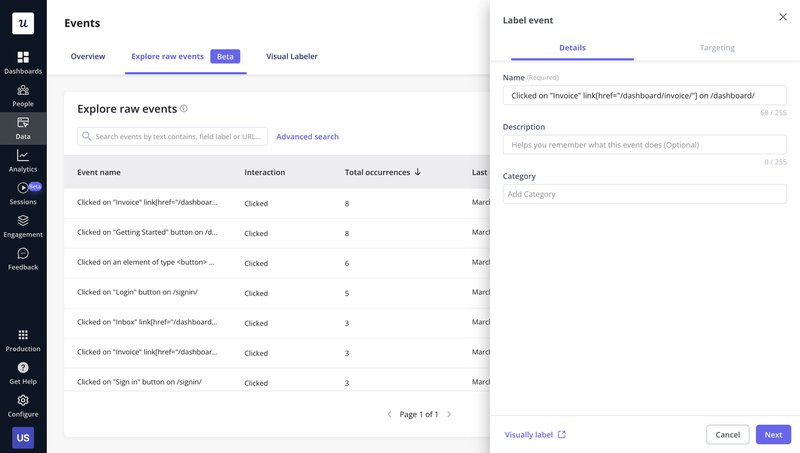
- Session replays: This feature lets you go granular and analyze friction at scale. Notice that users aren’t completing a key in-app process? Pull up replays of those sessions to see where they hesitate, rage-click, or skip a button. Once you’ve spotted the issue, you can leave a comment and tag teammates directly in the replay so fixes happen faster.
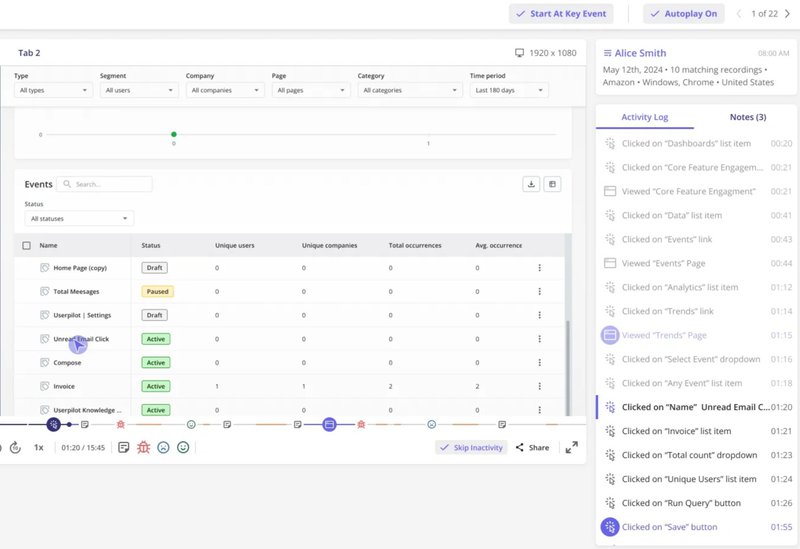
- Advanced analytics: Userpilot lets you generate funnel, path, and trend reports to identify where users drop off and what keeps them engaged over time. For example, imagine only 30% of your new signups remain active after their first month. Userpilot’s analytics reports can show you exactly where the other 70% are dropping off. Here’s an example of a funnel report generated with our platform:
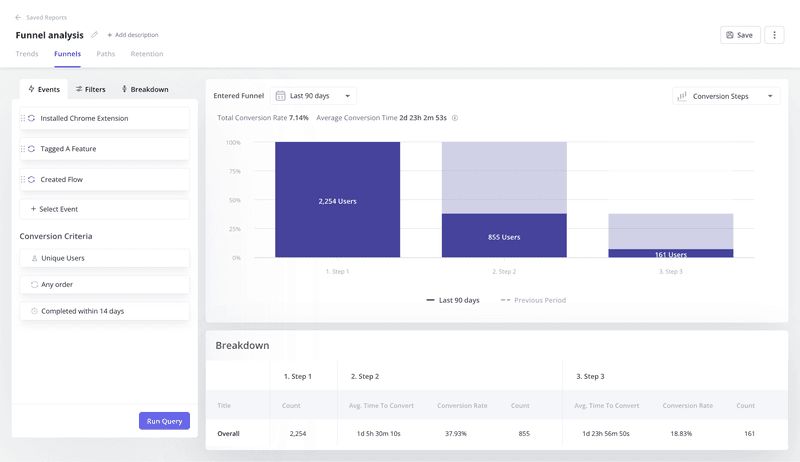
- In-app feedback surveys: Userpilot provides in-app survey tools to help you hear directly from your users. You can choose from ready-made NPS and CSAT templates or build your own custom questions to capture the feedback that matters most.
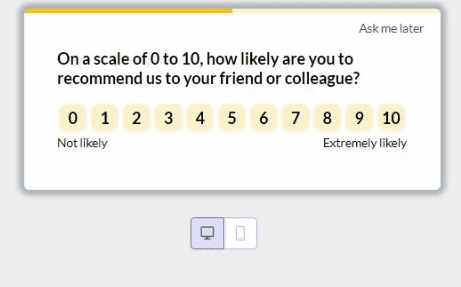
- Mobile analytics: Userpilot mobile lets you track events and screen views to see how users interact with your app in real time. Even more useful, mobile and web analytics live in the same platform, so you don’t need separate tools to get a complete view of customer behavior.
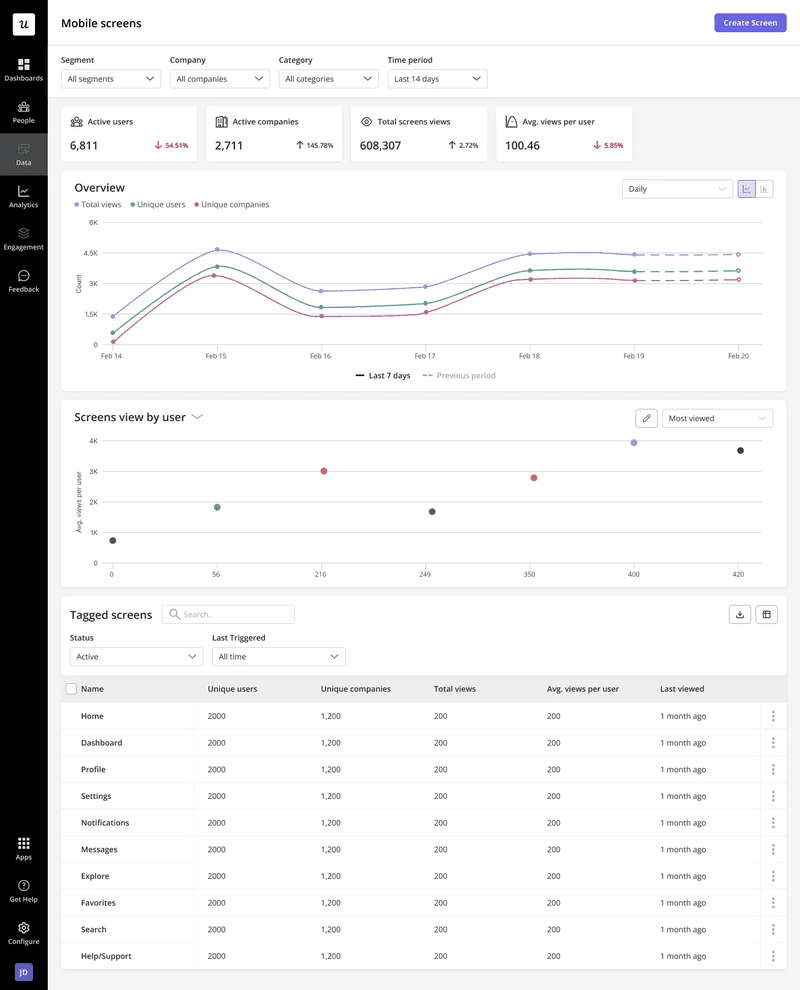
You can also launch in-app surveys to capture feedback directly from mobile users and use slideouts or carousels for mobile communication. All these features help you maintain the same level of visibility across platforms and deliver a consistent customer experience no matter where your users are.
Here’s what Leyre Iniguez, Customer Experience Lead at Cuvama, says after switching to Userpilot:
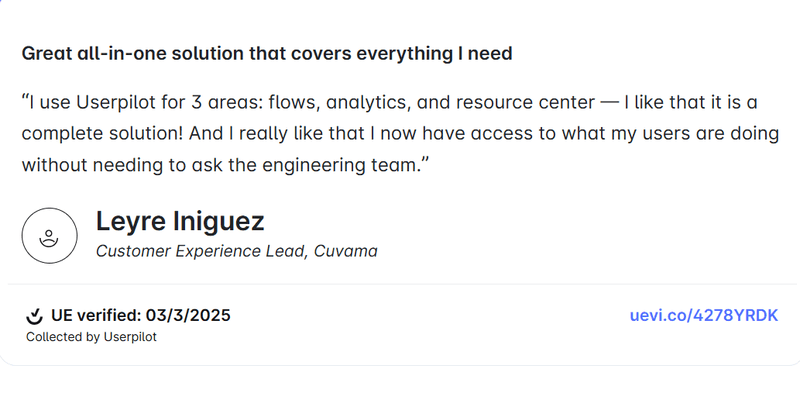
Pros:
- No-code builder: Userpilot lets you create flows, add UI elements, and tag features through the Chrome extension without touching code.
- Product experimentation: Userpilot’s built-in A/B testing capability helps you compare in-app flows and optimize based on what resonates most with users.
Cons:
- Learning curve for advanced features: While users praise how quickly they can get started, many reviewers note that mastering the full depth of Userpilot, especially its advanced segmentation, analytics, and A/B testing tools, takes time.
- Higher barrier to entry: Userpilot does not offer a free or very low-cost tier, which may make it less accessible for early-stage startups on a tight budget.
Userpilot pricing
Userpilot offers flexible, MAU-based pricing plans to suit different needs. The Starter begins at $299/month, with a 14-day free trial for users to try the product without any financial commitment.
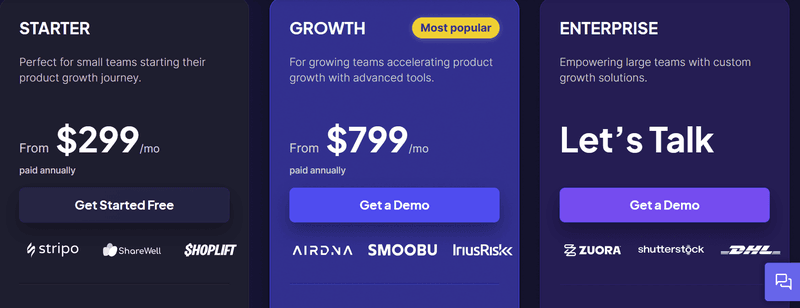
2. HubSpot Marketing Hub
Built on HubSpot’s customer relationship management (CRM) system, the Marketing Hub is an all-in-one inbound marketing platform that helps teams attract, engage, and convert users through data-driven campaigns.
Overall G2 rating: 4.4/5 ⭐️
Key features:
- CRM-powered marketing automation: HubSpot combines marketing automation with its CRM so every campaign is backed by real customer data. This keeps your emails, ads, and workflows aligned with what users actually need.
- Drag-and-drop builders: The platform empowers you to create emails, landing pages, and social posts without writing code. HubSpot also offers templates for each use case to make it simple to launch campaigns fast while keeping them on brand.
- Workflow automation: HubSpot lets you build automated onboarding flows, re-engagement campaigns, or lead nurturing sequences triggered by customer actions.
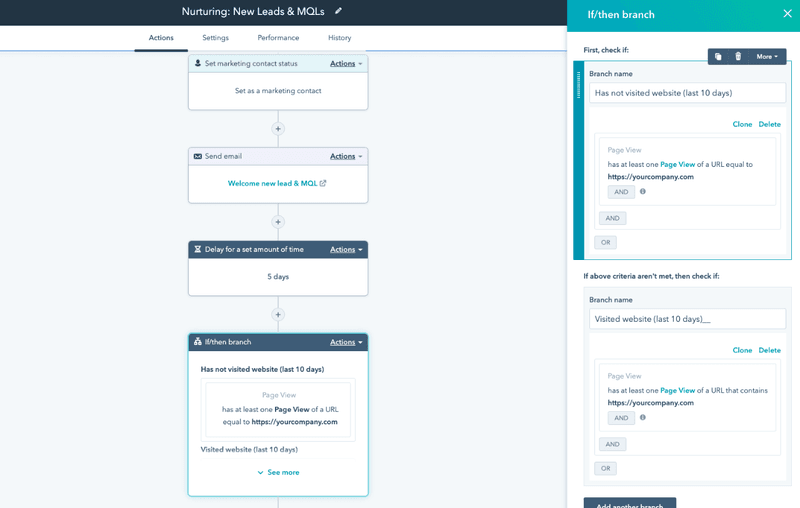
Pros
- Strong personalization: The behavior-based targeting and AI optimization help you deliver highly relevant customer experiences.
- Ecosystem and integrations: The platform works seamlessly with HubSpot’s Sales and Service Hubs and integrates with tools like Userpilot, Salesforce, and Slack.
Cons
- Feature bloat for small teams: Some advanced features may feel overwhelming or unnecessary if you’re just starting out.
- Customization limits: While flexible, HubSpot’s templates and reporting dashboards can feel restrictive compared to specialist tools.
HubSpot Marketing Hub pricing
HubSpot offers a free plan for up to two users. Paid plans start at $9 per month per seat and scale based on the number of seats, your marketing contacts, and whether you choose monthly or annual billing.
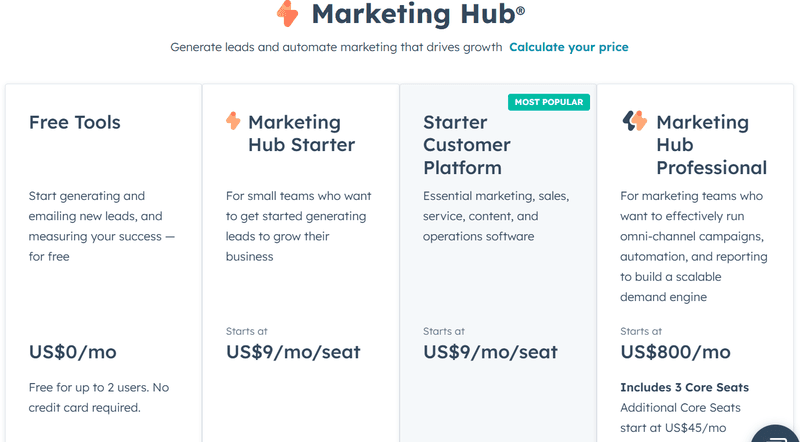
3. Intercom
Intercom is a customer communications platform that helps businesses build and manage customer relationships through a conversational approach.
Overall G2 rating: 4.5/5 ⭐️
Key features
- Real-time live chat and bots: Intercom lets you engage users instantly with customizable chat widgets and AI-driven bots. Its proprietary Fin AI agent uses NLP to understand what customers are asking and provides helpful, relevant responses, but costs $0.99 per resolution
- Product tours: Intercom provides a product tours feature that helps you launch no-code multi-step walkthroughs using tooltips, modals, and checklists. This is helpful for driving feature adoption, but unlike Userpilot, it comes at an additional monthly cost since that’s not Intercom’s main focus.
- Unified inbox and integrated helpdesk: Intercom gives you a unified inbox to manage customer conversations across multiple channels, making it especially valuable for customer support teams handling in-app messaging, email, and social media.
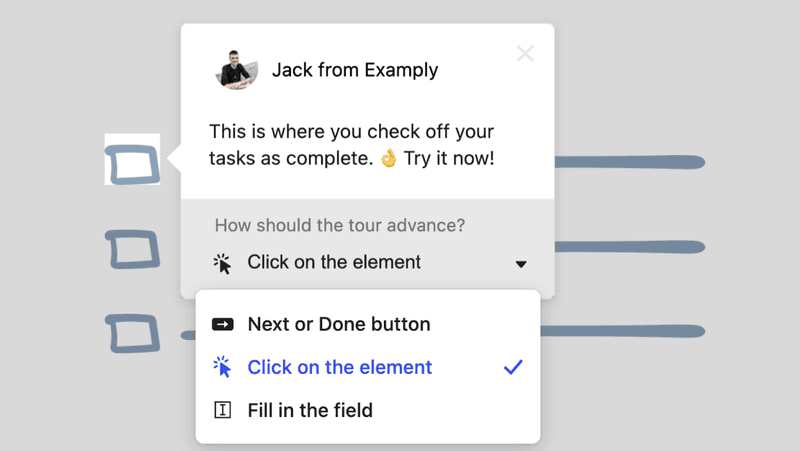
Pros
- Powerful conversational AI: The introduction of the Fin AI agent is a major pro. Users consistently praise its ability to resolve a high percentage of customer queries instantly.
- Intuitive and user-friendly interface: Intercom has a clean, modern, and intuitive design that helps teams get up to speed quickly and manage conversations efficiently.
Cons
- High pricing: This is the most frequent complaint. Intercom’s usage-based model can get expensive and unpredictable with per-seat fees, $0.99 per-resolution charges for the Fin AI agent, and extra costs for add-ons and messaging channels.
- Vendor lock-in: Once a business runs its support and messaging through Intercom, migrating away becomes a major project. Very few competing platforms provide true 1:1 feature parity, so teams usually have to rebuild flows, retrain bots, and adjust to a new interface and logic.
Intercom pricing
Intercom’s pricing starts at $29 per seat/month, with a 14-day free trial available across all plans.
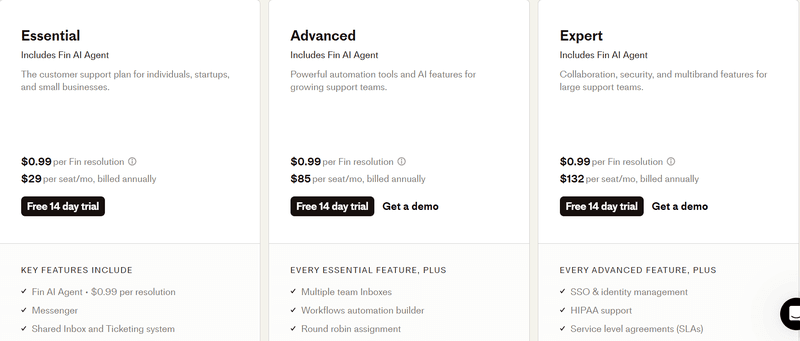
4. Braze
Braze is a customer engagement platform built for multichannel marketing. It helps brands deliver personalized messages across email, push notifications, in-app messaging, SMS, and more.
Overall G2 rating: 4.5/5 ⭐️
Key features:
- Omnichannel campaign orchestration: Braze equips you to launch real-time, personalized messaging across multiple marketing channels like email, web push notifications, SMS, and in-app nudges, all from a single dashboard.
- Flexible data activation and segmentation: Braze connects to your data wherever it lives. The platform can pull information from your CRM, data warehouse, or third-party systems and turn it into actionable audiences. You can then segment users based on real-time events, like in-app activities or subscription plans, as well as historical behaviors such as churn risk and lifetime value.
- Braze Canvas: This is the platform’s visual journey builder. You can use it to build onboarding flows, re-engagement campaigns, product announcements, and A/B tests, all without writing code. It also supports gradual feature rollouts and in-product messaging.
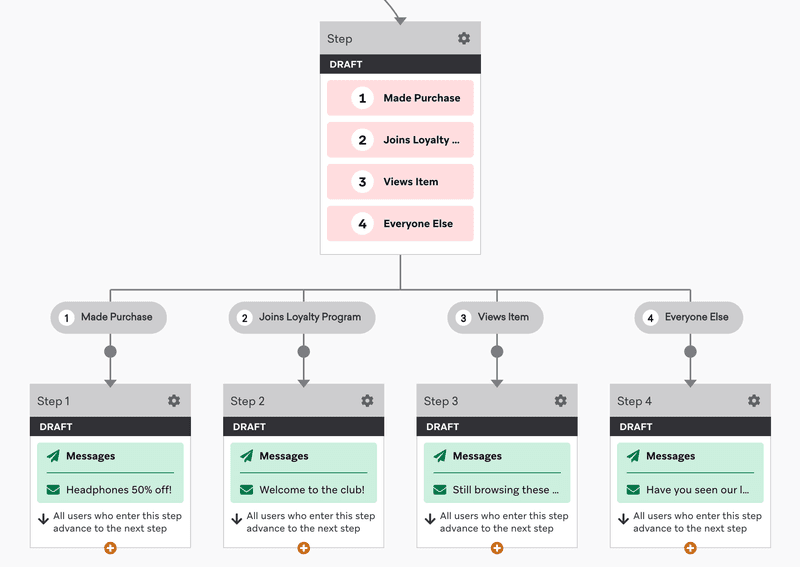
Pros
- Highly scalable: The platform is built for enterprise-level scale. Its infrastructure is designed to handle millions of data points and messages per minute without delays.
- Flexibility: With robust APIs and liquid templating for dynamic content, Braze allows technical teams to build advanced, highly customized use cases that go beyond what most customer engagement solutions support.
Cons
- Technical implementation and maintenance: While powerful, implementing Braze can be a complex and time-consuming process.
- Pricing at enterprise level: Braze is built for scale, and costs can be steep for smaller or early-stage SaaS teams.
Braze pricing
As with most enterprise-grade tools, Braze does not publish official pricing. Third-party data from Vendr suggests entry-level plans start around $28,000 per year, with larger deployments reaching $300K+ annually.
The good news is that Braze offers a 14-day free trial that allows you to test its features before committing.
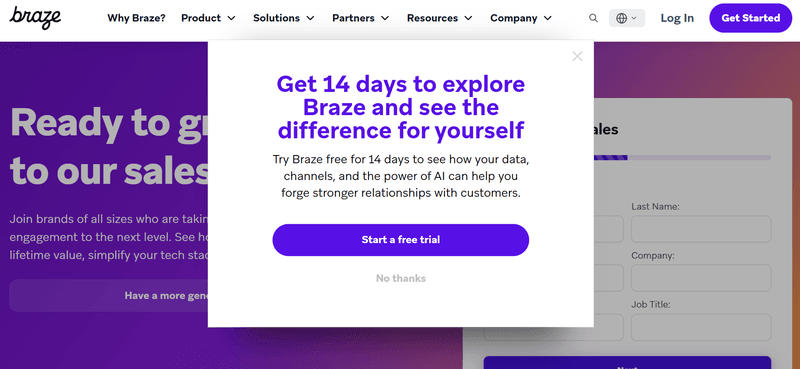
5. Iterable
Iterable is a cross-channel marketing platform that helps teams turn customer data into personalized, testable campaigns. Unlike Braze, Iterable is known for its ability to easily ingest and use diverse data sources without significant engineering bottlenecks.
Overall G2 rating: 4.4/5 ⭐️
Key features
- Journey orchestration: Iterable’s visual builder lets you create drag-and-drop workflows for onboarding, re-engagement, win-back, and other campaigns that span the entire customer lifecycle. You can also layer in event triggers and conditional logic for highly targeted messaging.
- A/B and multivariate testing: Iterable lets you run controlled experiments at every stage of the customer journey. You can quickly test subject lines, message timing, or channel mix to see what drives the best results.
- AI and predictive insights: Iterable’s AI features help optimize send times, recommend content, and predict churn or conversion likelihood, so your teams can act proactively.
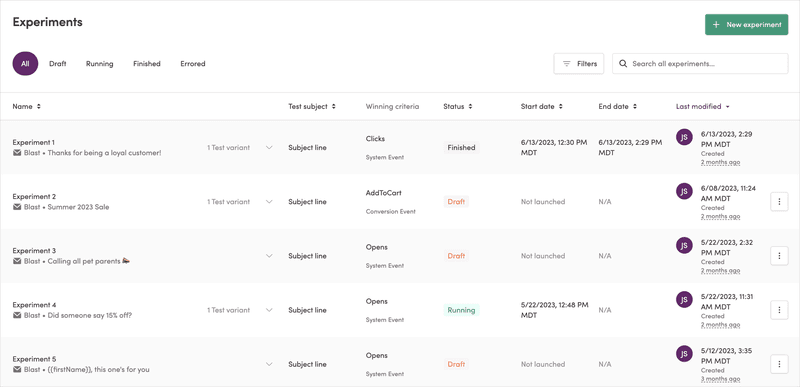
Pros
- Workflow automation and segmentation: Iterable excels at creating dynamic, behavior-driven campaigns using advanced segmentation. The visual builder makes crafting these workflows accessible, even for complex use cases .
- Excellent customer support: Reviewers across platforms like G2 and TechJockey consistently praise Iterable’s responsive and knowledgeable customer success teams.
Cons
- Reporting can be basic or clunky: Some users find the native reporting insufficient or unintuitive, often opting to export data or use external tools for deeper analytics.
- Mobile capabilities: Iterable supports push, in-app, and SMS, but it lacks the same depth of mobile-specific controls and templates that platforms like Braze provide.
Iterable pricing
Iterable offers custom pricing based on your company’s message volume, contact list size, and feature needs. Like Braze, data from Vendr suggests Iterable’s low tiers go for an average of $27,720 per annum, with higher contracts reaching $400K+ per year.
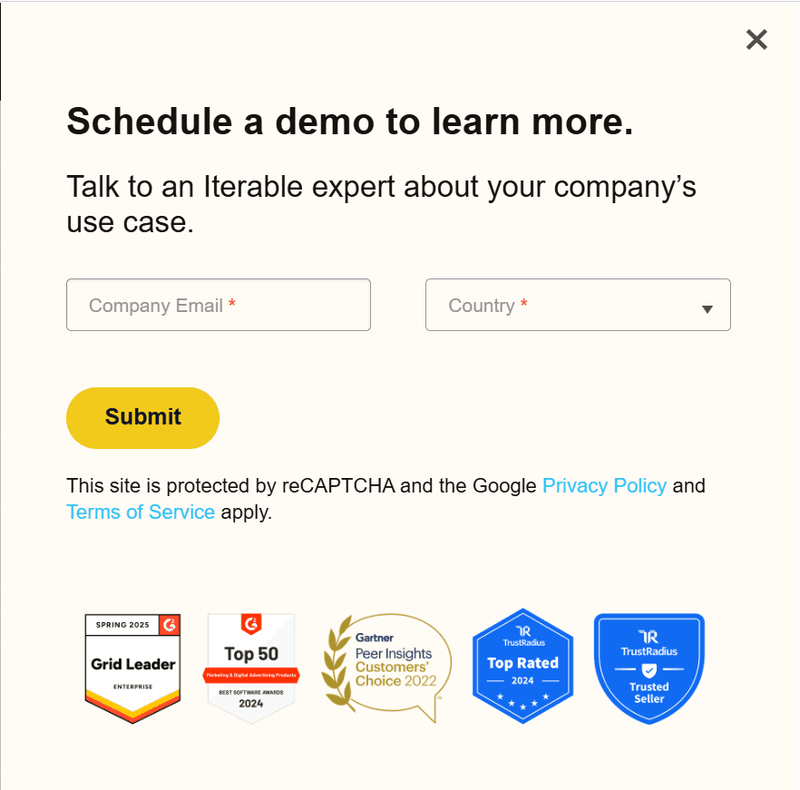
6. ActiveCampaign
ActiveCampaign is a unified customer experience automation platform combining email marketing, CRM, and sales automation. It’s built to help teams deliver behavior-driven campaigns and seamless engagement across the entire customer journey.
Overall G2 rating: 4.5/5 ⭐️
Key features:
- Marketing automation builder: This is arguably ActiveCampaign’s flagship feature. It uses a visual, drag-and-drop workflow builder that makes it simple to create sophisticated, multi-step automations. You can set up triggers based on user behavior, and the automation will automatically follow up with emails, assign tasks to a sales rep, update a contact’s score, and keep sales teams aligned with marketing.
- Omnichannel messaging: Beyond email, the platform supports SMS, site messages, and integrations with social platforms.
- A/B testing and reporting: You can test subject lines, email designs, and workflows, then analyze results in real-time dashboards.
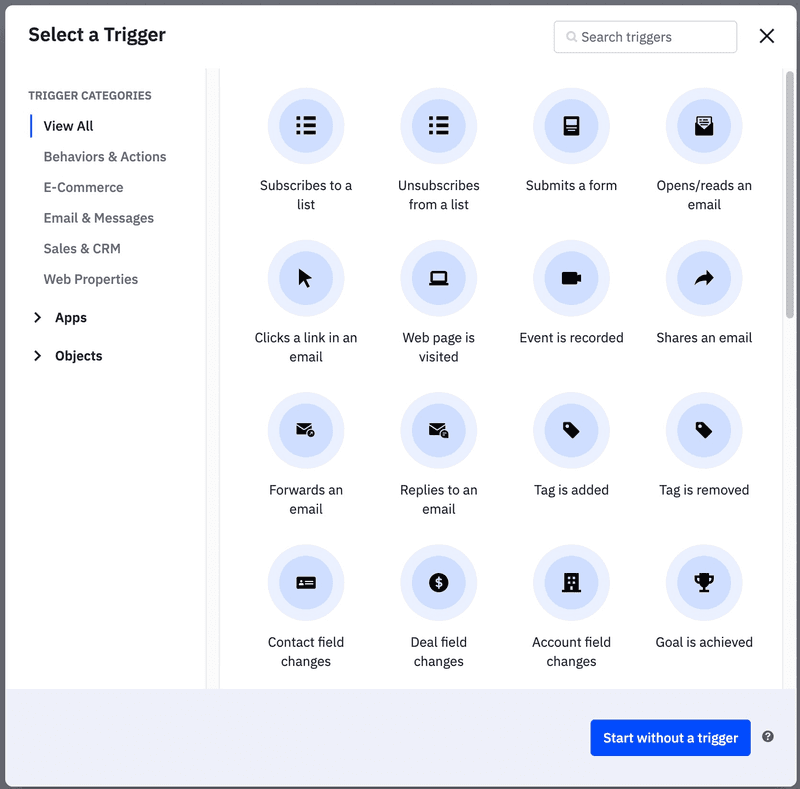
Pros
- Integrated marketing and sales: Unlike platforms that require separate subscriptions for marketing and sales, ActiveCampaign’s built-in CRM and sales automation features work seamlessly together.
- Template library: ActiveCampaign provides hundreds of pre-built workflow templates to help you jumpstart campaigns and reduce setup time.
Cons
- Limited customization in lower tiers: The entry-level plans have some frustrating limitations. For example, some plans cap the number of automations you can have, and basic features like custom reporting or lead scoring are often reserved for higher-tier plans.
- Learning curve: While powerful, the features and automation depth may feel overwhelming for those seeking a simple email engagement tool.
ActiveCampaign pricing
ActiveCampaign offers a 14-day free trial. The paid plans start at $15 per month for 1,000 email contacts.
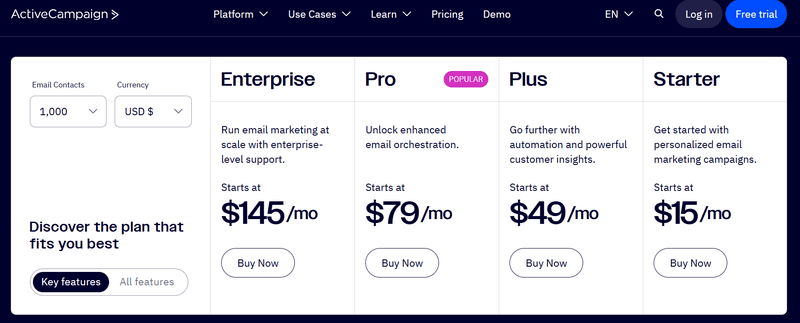
7. Mailchimp
Mailchimp is a marketing automation and email platform best known for its ease of use and accessible design tools. It’s especially popular with small businesses and startups because it allows users to create campaigns quickly without technical expertise.
Overall G2 rating: 4.4/5 ⭐️
Key features:
- Audience management and segmentation: Mailchimp helps you organize contacts with tags, segments, and behavioral data, so you can send more relevant messages to the right groups.
- Analytics and reporting: The platform’s built-in dashboards provide insights on open rates, clicks, conversions, and revenue, to help you track performance and optimize campaigns.
- All-in-one engagement marketing suite: Mailchimp offers additional tools that allow you to create landing pages and forms, manage social media content, and deploy digital ads.
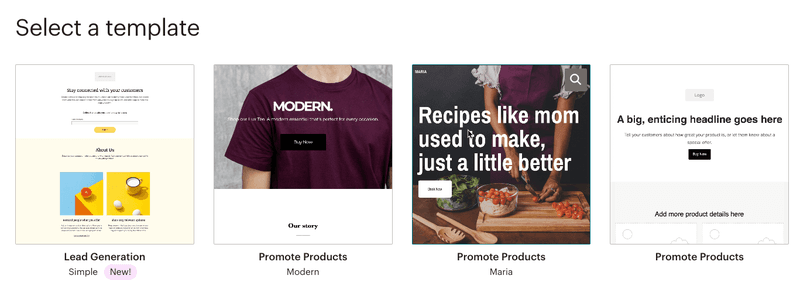
Pros
- Generous free plan: Mailchimp offers a free plan that includes basic email marketing, forms, and landing pages for up to 500 contacts. While this plan has become more limited over the years, it remains an excellent way for new businesses to get started with email marketing at no cost.
- User friendliness: Mailchimp consistently earns praise for its intuitive interface and drag‑and‑drop editors, which make it a great choice for those just starting out with email-driven engagement marketing.
Cons
- Expensive pricing as you grow: Unlike most competitors, Mailchimp charges for every contact, including duplicates and unsubscribed contacts, which can dramatically increase the monthly bill.
- Limited customer support: The free plan has very limited support, and even on paid plans, users often report that support is not as responsive or accessible as they would like.
Mailchimp pricing
Mailchimp’s paid plans start at $13 per month for 500 contacts.
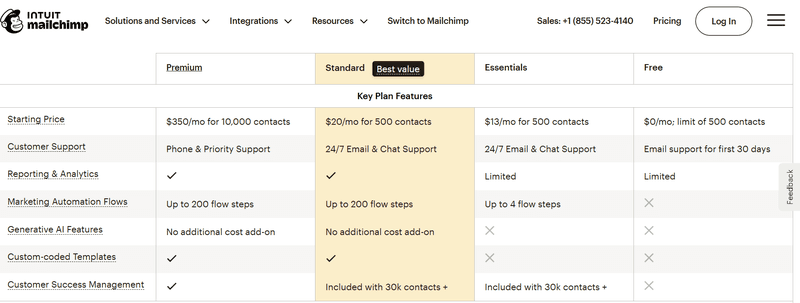
8. Klaviyo
Klaviyo is an automation platform that helps businesses use customer data to deliver personalized multichannel campaigns that drive retention and revenue.
Overall G2 rating: 4.6/5 ⭐️
Key features
- Email and SMS marketing: Klaviyo combines email and SMS campaigns under one roof, so you can run multi-channel engagement without juggling tools.
- Analytics: Klaviyo offers performance dashboards with detailed insights into revenue attribution, engagement, and lifetime value.
- Advanced Segmentation: With the detailed data it collects, Klaviyo enables hyper-specific and dynamic segmentation. You can create segments based on almost any criteria, such as past purchase behavior, website activity, or even geographic location, combined with customer lifetime value.
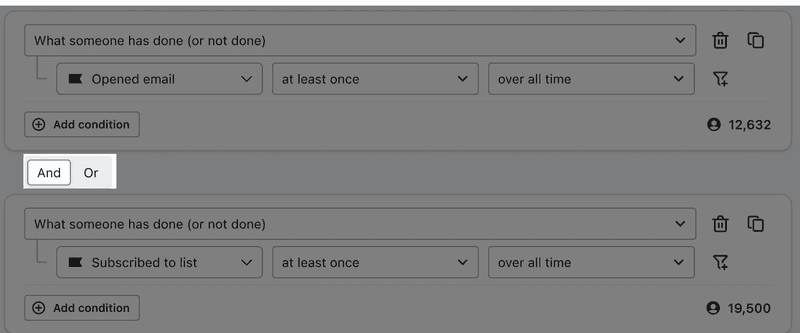
Pros
- Predictive analytics: The platform’s AI capabilities can predict customer behavior, such as a customer’s likelihood to subscribe or churn. This allows you to create proactive campaigns and optimize your marketing efforts for future revenue.
- Automation templates and flow builder: Klaviyo’s prebuilt flows for welcome messages and post-purchase follow-ups make setup fast, while the drag-and-drop editor supports custom automation.
Cons
- Learning curve for beginners: Advanced segmentation and data-driven workflows can feel complex for non-technical teams, especially compared to simpler tools like Mailchimp.
- Support limitations: Some users report that customer support is slow and limited on lower-tier plans.
Klaviyo pricing
The platform offers a freemium pricing model with the paid plan starting at $45 per month.
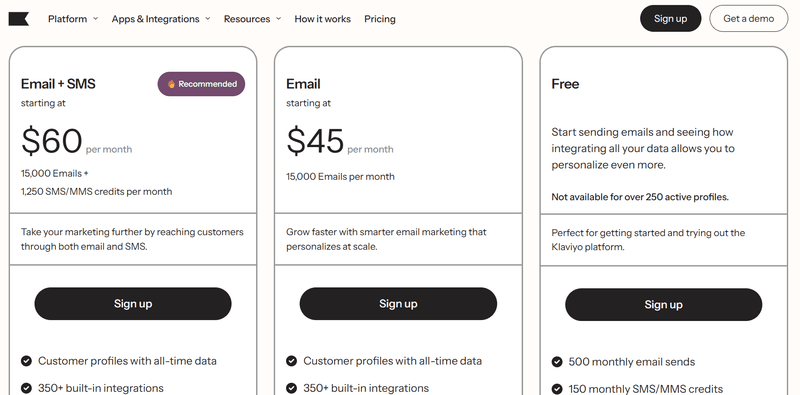
9. MoEngage
MoEngage markets itself as an “insights-led” customer engagement platform because it uses behavioral analytics and data-driven insights to inform and optimize marketing campaigns.
Overall G2 rating: 4.5/5 ⭐️
Key features
- Sherpa AI engine: This is MoEngage’s proprietary AI and machine learning engine. It’s integrated throughout the platform and helps with personalization, campaign optimization, and churn prediction.
- Cross-channel messaging: The platform lets you engage customers through push notifications, email, SMS, in-app messaging, and web.
- Journey orchestration: MoEngage’s visual flow builder allows you to design automated customer journeys that respond to events like sign-ups, subscriptions, or inactivity. You can add conditional logic to adapt each path to individual user behavior.
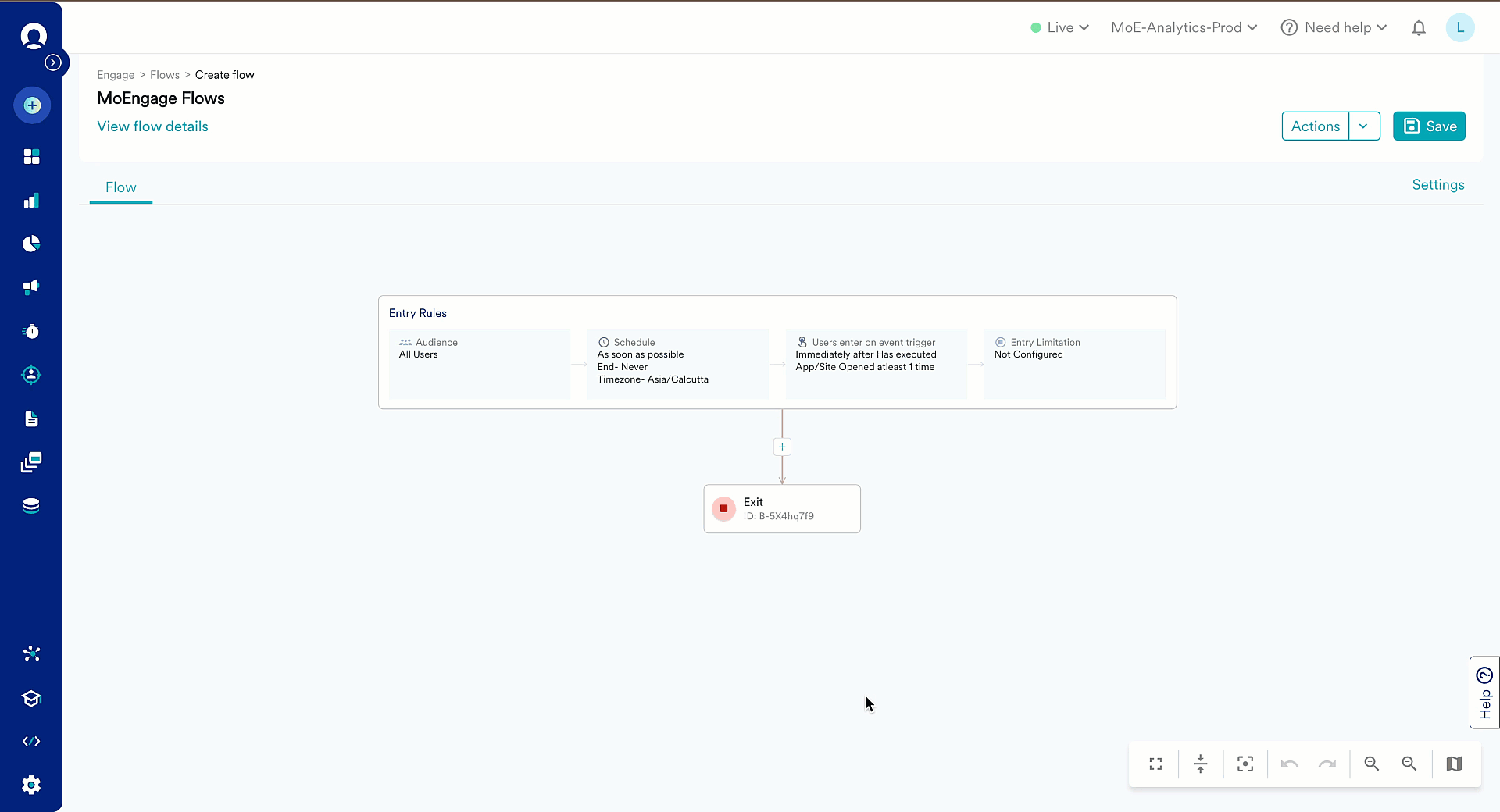
Pros
- Insights-led engagement: MoEngage’s major strength is its emphasis on data and analytics. The platform provides extensive tools for understanding user behavior, building funnels, and analyzing cohorts.
- Mobile push amplification: MoEngage provides smart fallback mechanisms to improve notification deliverability, even in low-connectivity scenarios.
Cons
- Interface complexity: While powerful, MoEngage can be complex, especially for new users. The sheer number of features and the need to connect various data sources can lead to a steep learning curve.
- Performance and reporting limitations: Some reviewers report sluggish segmentation for large datasets, delayed data syncs in triggered campaigns, and difficulty exporting or customizing reports.
MoEngage pricing
Similar to other enterprise-level platforms like Braze and Iterable, MoEngage’s pricing is not publicly listed and is often a major barrier for smaller companies.
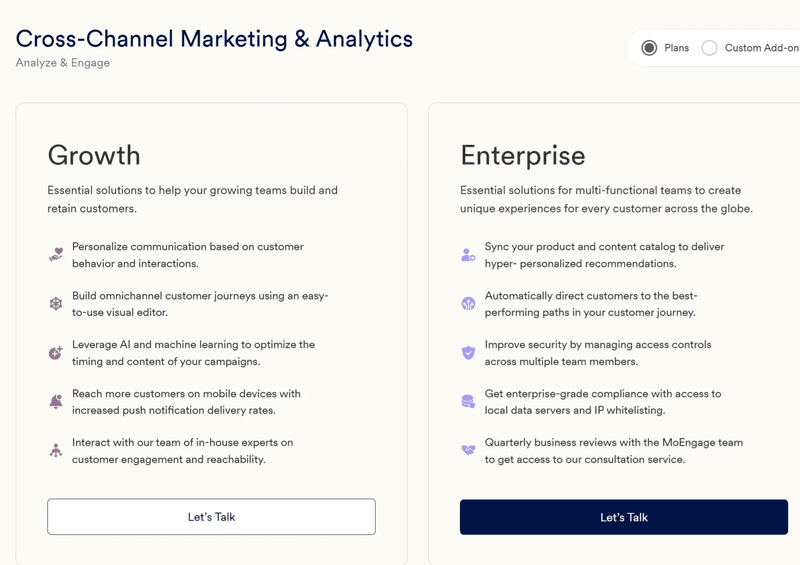
10. Freshmarketer
Freshmarketer is a customer engagement and marketing automation platform from Freshworks. It helps businesses manage email campaigns, customer journeys, and multichannel messaging while tying directly into Freshworks’ CRM and support ecosystem.
Overall G2 rating: 4.1/5 ⭐️
Key features
- Omnichannel messaging: Freshmarketer allows you to engage with customers across email, SMS, WhatsApp, and chatbots, all from a single dashboard.
- AI-powered automation: Freshmarketer’s Freddy AI helps generate content, optimize send times, score leads, and launch campaigns quickly.
- Conversion rate optimization tools: This is a key differentiator for Freshmarketer. The platform provides heatmaps, session replay, A/B testing, and funnel analytics capabilities to help you understand user behavior, improve customer engagement, and increase conversion.
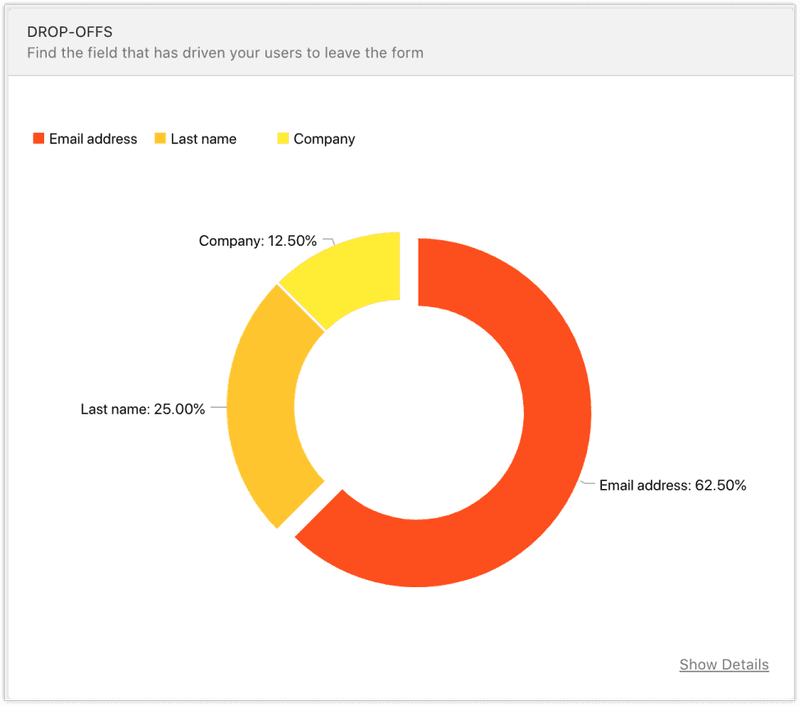
Pros
- Unified customer view: Being part of the Freshworks family is a significant advantage. Freshmarketer seamlessly integrates with Freshsales and Freshdesk, creating a 360-degree view of the customer across marketing, sales, and support.
- User-friendly and intuitive interface: The platform is widely praised for its ease of use. Its drag-and-drop journey builder and clean dashboard make it accessible for marketers of all skill levels.
Cons
- Limited Integrations: A recurring complaint is that Freshmarketer’s integrations are heavily biased toward other Freshworks products. While it does integrate with some external apps, users report that connecting with certain popular third-party tools can be challenging or limited compared to competitors.
- Scalability concerns: Some users have raised concerns that Freshmarketer may not be as scalable as enterprise-level solutions like Braze or MoEngage for very large organizations with complex needs and a high volume of users.
Freshmarketer pricing
Freshmarketer offers a free plan limited to 100 marketing contacts. The paid plan starts at $15 per month and has a 21-day free trial.
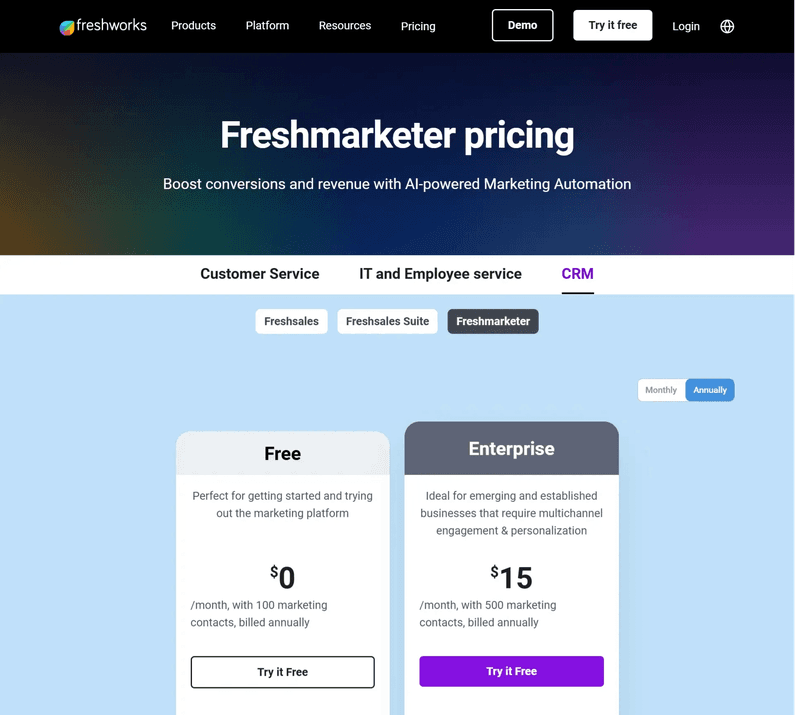
11. Qualtrics XM
Qualtrics XM is a comprehensive experience management platform that captures and connects customer, employee, product, and brand insight, all in one central system.
Overall G2 rating: 4.4/5 ⭐️
Key features
- Extensive customer feedback features: Qualtrics lets you trigger in-app surveys and use banners or pop-ups for collecting customer feedback on websites and mobile apps. It can also ingest data from call center conversations, online reviews, and social media to provide a more complete view of customer needs.
- Automated flows: The platform allows you to automate a response based on customer feedback. This could be as simple as sending a follow-up email to a customer who gives a low score or as complex as routing a high-priority support ticket directly to customer support agents.
- AI-powered analytics: Qualtrics is a leader in using AI and machine learning to make sense of large amounts of data. Its iQ engine can analyze unstructured text feedback (from surveys, social media, etc.) to identify sentiment, themes, and key customer satisfaction drivers.
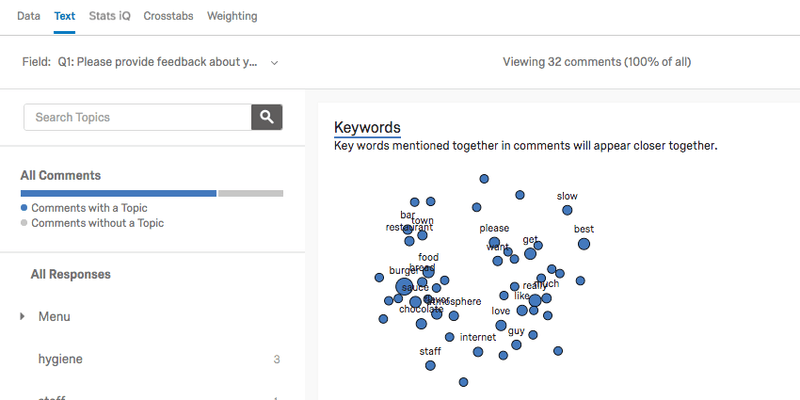
Pros
- Cross-functional value: From HR to marketing and customer service teams, Qualtrics is used across various departments to spot friction points and help teams prioritize improvements effectively.
- Advanced survey: Qualtrics offers sophisticated survey features like branching logic, randomization, and translation, making it easy to design complex research projects and gather high-quality data.
Cons
- Implementation challenges: The initial setup is a complex process that often requires a dedicated team of specialists and a well-defined data strategy.
- Performance and usability limitations: Qualtrics can feel overwhelming at times, especially when working with heavy datasets. Dashboards may load slowly, the interface isn’t always intuitive, and organizing workflows or managing participants lacks flexibility.
Qualtrics XM pricing
Qualtrics XM does not publish public pricing. It’s a custom, usage-based model that varies depending on your needs.
According to Vendr, the median annual spend for Qualtrics XM is $27,625, with actual costs ranging from $5,891 to over $122,000, depending on chosen modules and scale.
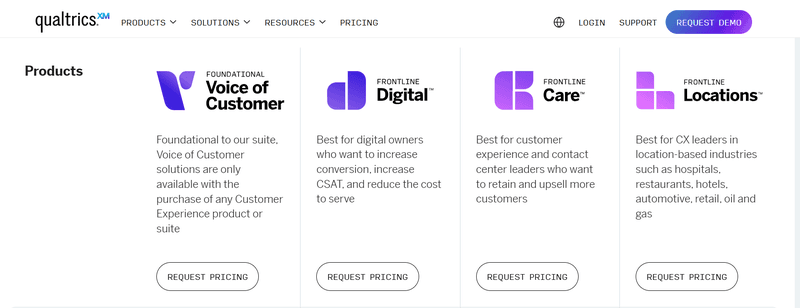
12. Drift
Drift (now part of Salesloft) is a conversational marketing platform designed to turn anonymous website traffic into sales pipelines.
Overall G2 rating: 4.4/5 ⭐️
Key features
- Intelligent lead routing: Drift automatically routes qualified leads to the right person or team based on rules you set.
- Drift intel: This feature provides real-time insights into who is on your website. It can identify the company and key contact information of an anonymous visitor and use that data to trigger personalized conversations.
- Conversational AI and chatbots: Drift’s AI-powered chatbots, often referred to as “Playbooks,” are its central feature. These chatbots are far more advanced than simple, button-based bots. They use natural language understanding to engage with visitors in a human-like way, answer open-text questions, qualify leads, and even book meetings directly on a sales rep’s calendar.
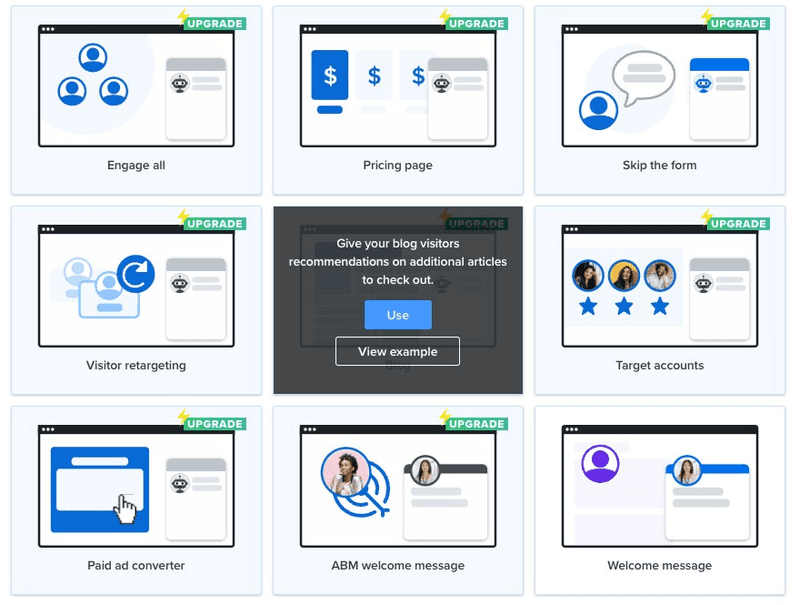
Pros
- B2B sales cycle acceleration: Drift shortens the traditional lead-to-deal timeline by replacing static forms with instant conversations that qualify and redirect leads.
- Easy to adopt: Drift’s interface is intuitive, and deployment is smooth.
Cons
- Not ideal for customer support: While Drift offers live chat for support, its primary focus is on sales. Many users find its support features to be an afterthought and less robust compared to platforms like Intercom or Zendesk.
- Over-reliance on live traffic: Drift delivers the most value when you have steady inbound website traffic. Teams with lower visitor volumes may struggle to see a strong ROI.
Drift pricing
Before its 2024 acquisition by Salesloft, Drift’s pricing started at around $2,500 per month.
Today, Salesloft offers Drift under a custom pricing model as part of its product suite, so the best way to get accurate numbers is to contact the Salesloft team directly for a tailored quote.
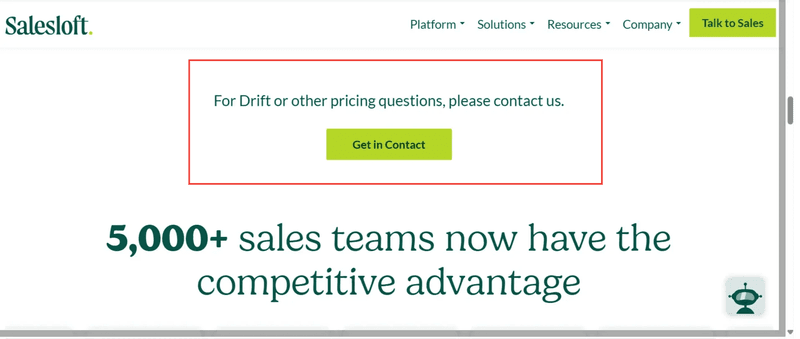
13. Zendesk Sunshine Conversations
Zendesk Sunshine Conversations serves as a unified API layer that connects a company’s business systems (like its CRM or help desk) to every popular messaging channel, from WhatsApp and Facebook Messenger to SMS and in-app chat.
Overall G2 rating: 4.1/5 ⭐️
Key features
- Customizable chat experiences: The platform supports interactive elements like carousels, quick replies, and buttons, all of which make customer chats more engaging than plain text.
- Bot and automation support: Sunshine Conversations integrates with AI chatbots and automation workflows to handle FAQs, route conversations, and scale support without overloading human agents.
- Unified conversation threads: The platform merges interactions from different channels into a single, continuous conversation, so agents and customers don’t lose context when switching platforms.
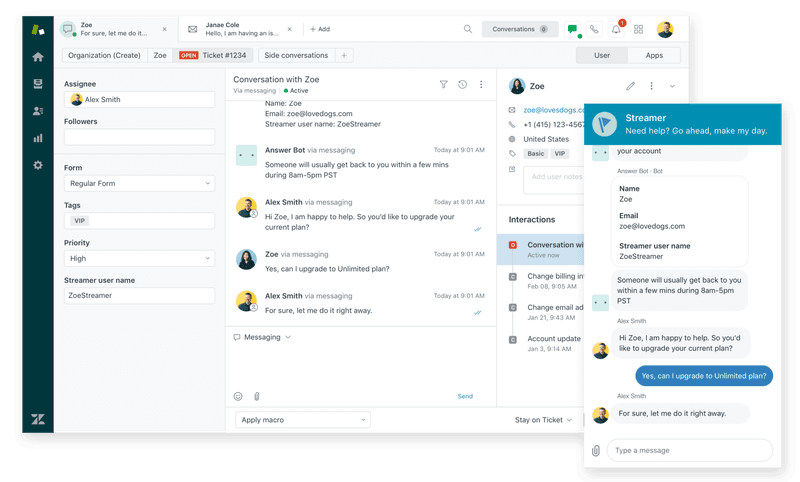
Pros
- Seamless Zendesk integration: Built natively to extend Zendesk, the platform syncs messages, customer data, and conversation history directly into support and CRM workflows.
- Continuous conversations: Unlike many live chat solutions, where the conversation is lost when a visitor leaves the page, Sunshine Conversations saves the conversation history. This allows customers to pick up a conversation where they left off, even if they switch devices or channels.
Cons
- Requires technical expertise: As an API-first platform, non-technical teams may struggle to unlock its full potential without developer support.
- Learning curve for setup: Building and maintaining custom conversational flows can take significant upfront investment in time and resources.
Zendesk Sunshine Conversations pricing
A low-volume version of Sunshine Conversations is included with Zendesk’s Suite Professional and Suite Enterprise plans. The latter is custom-priced, while the former goes for $115 per agent per month with annual billing. Also, Zendesk allows you to use third-party chatbots, but you’d need to purchase an add-on.
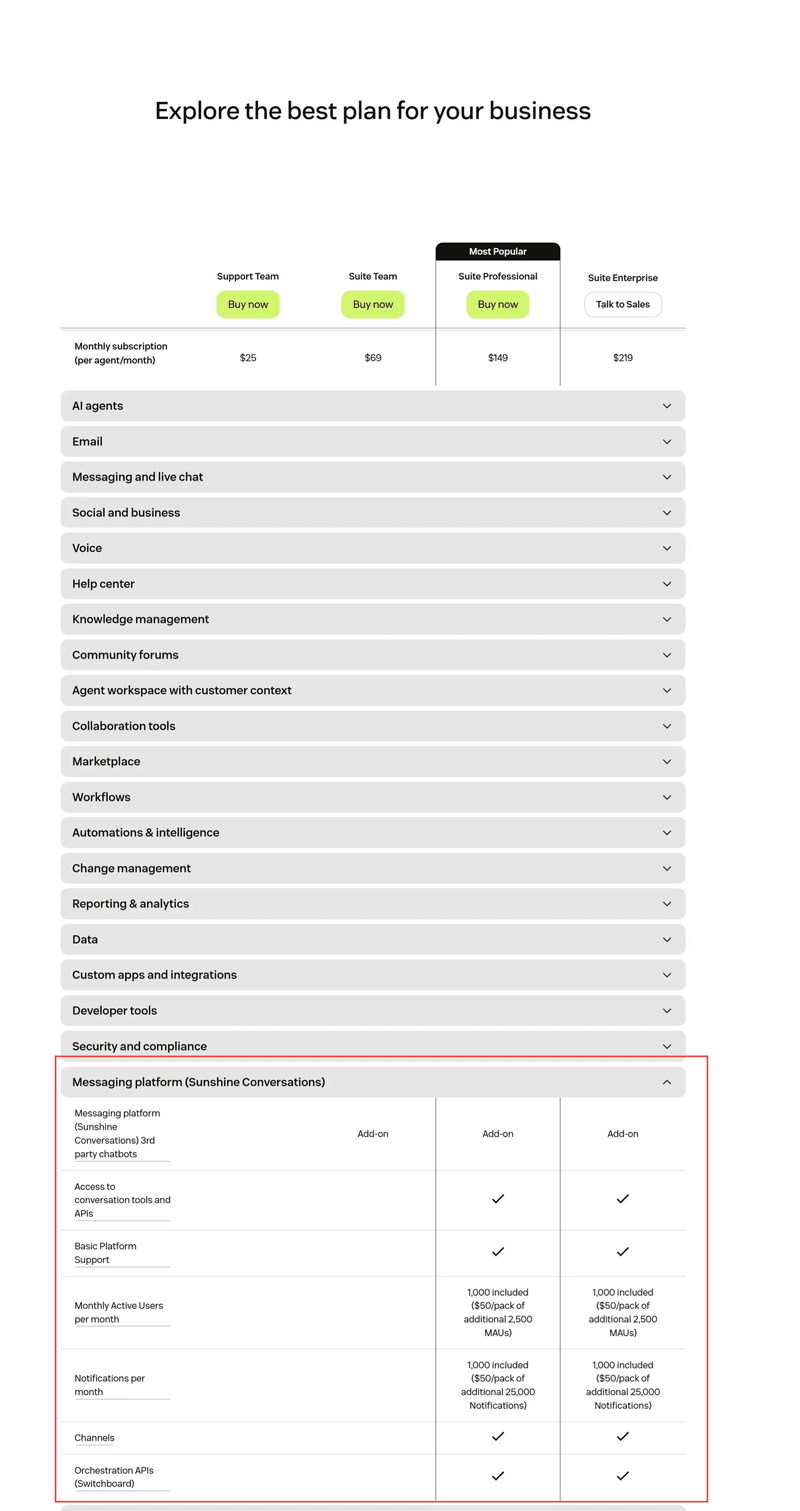
Engagement tools are the new loyalty programs
Every tailored nudge, well-timed message, and seamless conversation reinforces why your product is worth sticking with. Over time, this consistency creates loyalty that no coupon or reward card could ever match.
All 13 products I shared have the potential to drive engagement, retention, and customer loyalty. The real question is: which one fits your team best? My recommendation is to start with your current priorities and choose the platform that solves those first.
Try Userpilot if you’re looking for an engagement marketing tool that lets you track behavior, collect feedback, and build in-app experiences code-free, while keeping pricing transparent and predictable. Book a demo to discuss your needs.
FAQ
What are engagement tools?
Engagement tools are software platforms that help businesses interact with customers across touchpoints. They track behavior, collect feedback, and enable personalized experiences that keep users active, satisfied, and loyal.
Which tool is commonly used for engagement marketing?
Popular user engagement tools include Userpilot for in-app engagement, HubSpot for marketing automation, and Intercom for conversational support.
There’s no one-size-fits-all option. The right customer engagement platform depends on your company’s growth stage, goals, and budget.
What is engagement marketing?
Engagement marketing is a strategy that focuses on building ongoing customer relationships through personalized, timely, and meaningful interactions, rather than one-off campaigns.

